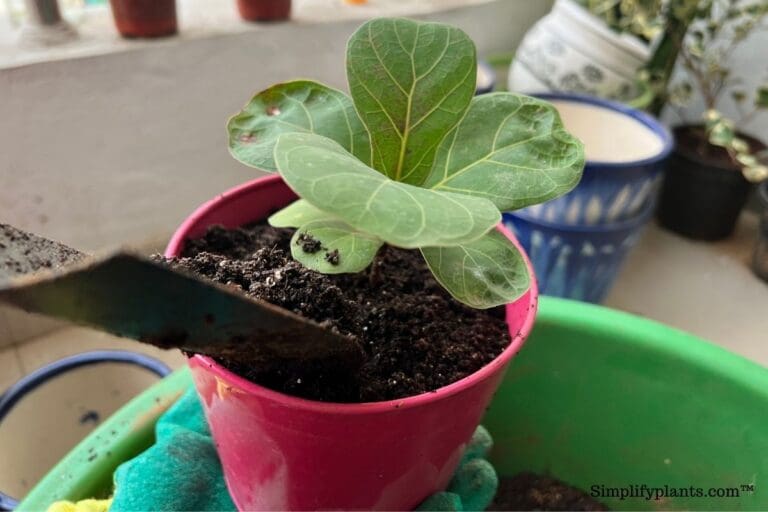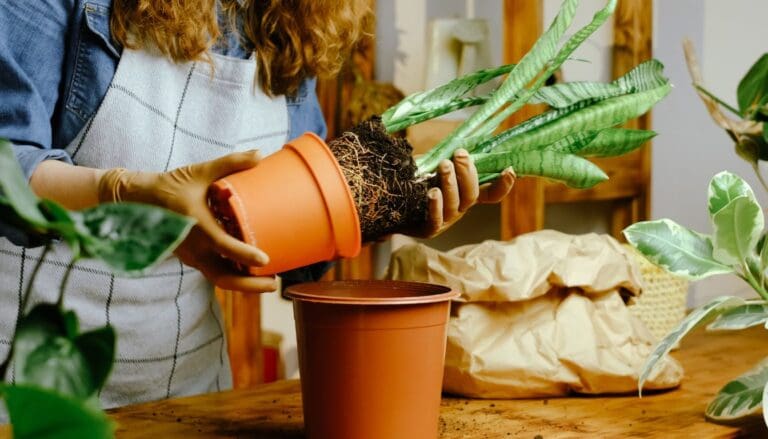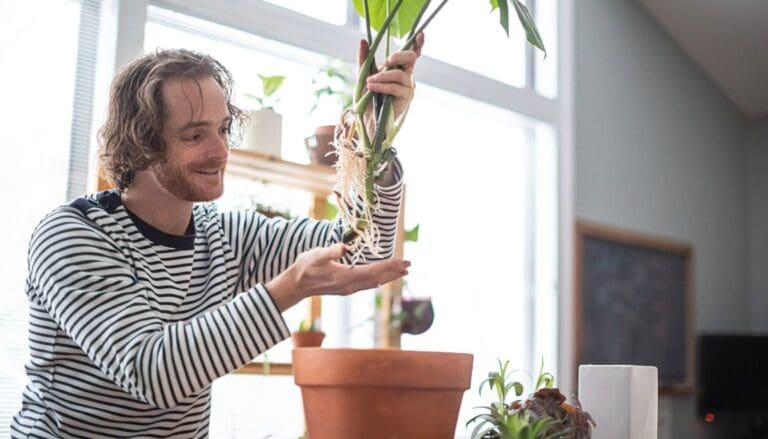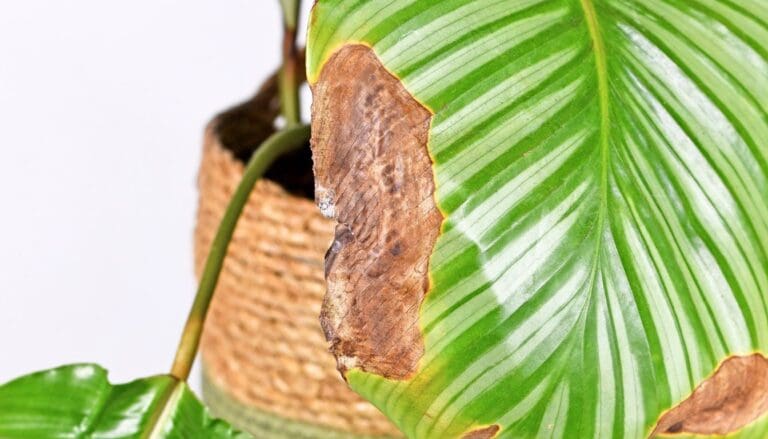Why Is My Arrowhead Plant Not Growing? (Causes+How To Fix)
Arrowheads are popular houseplants that are known for their lush variegated foliage. Sometimes it’s disappointing that you put so much effort into caring for it, but your plant doesn’t seem to grow.
Arrowhead plant goes to a dormant stage during the late fall and winter. So, if your plant is not growing during that season, it’s natural. Apart from that, improper lighting, insufficient nutrition, and pests can affect the growth of arrowhead plants.
Let us discuss the reasons behind slow growth in arrowheads and the steps you can take to encourage growth in your plant.

Please note: Simplify Plants is reader-supported. Some links in the post are affiliate links and I get a commission from purchases made through links in the post.
How fast do arrowhead plants grow?
Arrowheads are considered moderate-growing plants.
They grow along the ground or trees in their natural environment, and a 4-inch little plant can grow as tall as 32-65 feet (10-20m).
A small arrowhead plant can turn into a bushy shrub within a few months in the indoor environment.
A stem of an arrowhead plant will grow roots 1-2 weeks, and new leaves will start to come within4 weeks.
When grown as a houseplant, the average height of an arrowhead plant is about 2 feet (60 m), and some varieties can climb up to 4 feet (1.2 m) or more.
Arrowheads will show maximum growth during the spring and summer, which is the growing period.
They do not show any growth during winters and save energy to survive their dormant period.
Why is my arrowhead plant not growing?
Arrowheads will face growth problems if they do not get the ideal care or conditions.
Even if you’re providing it with all the ideal growing conditions, somewhere, something might be wrong.
If your plant is not growing, do not get worried.
Instead, take time to understand what’s wrong with your plant and find out the solution to fix the same.
Lets us discuss the possible reason that slows down the growth of your arrowhead plant in detail.
- Improper lighting
- Wrong watering methods
- Insufficient nutrition
- Inappropriate soil mix
- Wrong pot size
- Low humidity levels
- Temperature fluctuations
- Stress
- Pest attack
- Season
Lets us understand the above points in detail.
Improper lighting

Arrowheads can tolerate different types of lighting conditions.
But an understanding of its exact sunlight requirement is important for keeping it healthy.
They grow well under dappled sunlight from the tree canopies in their natural habitat.
As a houseplant, they will grow best in bright indirect light.
They can also grow in low light conditions but exposing them to very low light levels for a long period will slow down their growth rate.
If you notice trailing varieties become straggly with scanty foliage, you must understand your plant is not receiving enough light.
Without sufficient light, the leaves will start losing their color, the plant will become weak, and will fail to perform the process of photosynthesis.
In contrast, exposure to direct sunlight can lead to leaf scorching and crispy leaves.
Also read: Arrowhead Plant Light Needs: What Type, How Much & More
Wrong watering methods

A wrong watering schedule will disturb the growth of your Syngonium.
Providing them with proper and consistent soil moisture is important for their healthy growth.
The wrong watering method can cause both overwatering and under the watering situation.
In the case of underwatering, the plant will get dehydrated and fail to absorb water and nutrients from the soil.
Due to lack of it, they will not grow, their leaves will turn dry, crispy and the bottom leaves will start to fall.
Whereas in the case of overwatering, the soil will become soggy.
The excess moisture will reduce the oxygen level in the soil, due to which the roots will fail to breathe properly and will fail to function.
The roots will start to decay and can get root rot problems.
Such damaged roots will not supply water and nutrients to the plant, and thus there will be no growth.
The leaves will get discolored, and the plant will become weak and struggle to survive.
Also read: How To Water Arrowhead Plant? (How Often+Summer & Winter)
Improper fertilization

Your arrowhead will need some amount of fertilizers to thrive.
Insufficient nutrition is one of the reasons why your plant is not growing.
Fertilizer adds missing nutrients in the soil that supports the plant’s growth.
Fertilization in the growing season is important as the soil alone cannot provide all the nutrients to the plant.
Arrowheads are moderate feeders, and overfertilizing them can seriously affect their health.
Fertilizers have salts, and an excess of it will damage the plant’s root system, and without healthy roots, that plant will have no growth.
You should avoid overfertilizing.
Otherwise, you will end up losing your plant.
Also read: How Often Should You Fertilize Arrowhead Plant? (Best Fertilizer For Arrowhead)
Inappropriate soil mix

A wrong potting mix can stunt the growth of your arrowhead plant.
Arrowhead prefers fertile potting soil that can hold enough moisture for the plant and drain the excess water through drainage holes.
If the soil is dense, it will retain more moisture and cause overwatering issues.
Such soil can cause root rot problems and stop your plant’s growth by damaging the roots.
But if the soil has more sand content, it will fail to retain enough water and experience underwatering issues.
Therefore, selecting the correct soil mix is important and must not be ignored.
Also read: What Kind Of Soil For Arrowhead Plant? (+Best Soil Mix)
Wrong pot size

A wrong-sized pot can be one reason why your arrowhead plant has stopped growing.
The pot for the arrowhead should be proportionate to its size.
In case the pot is too small, the plant will get root-bound, and the roots won’t get the space to grow properly.
On the other hand, if the pot size is too big, it will hold more soil and water and create an overwatering situation that will not allow your plant to grow.
Also read: What happens when you put a plant in too big of a pot?
Low humidity levels
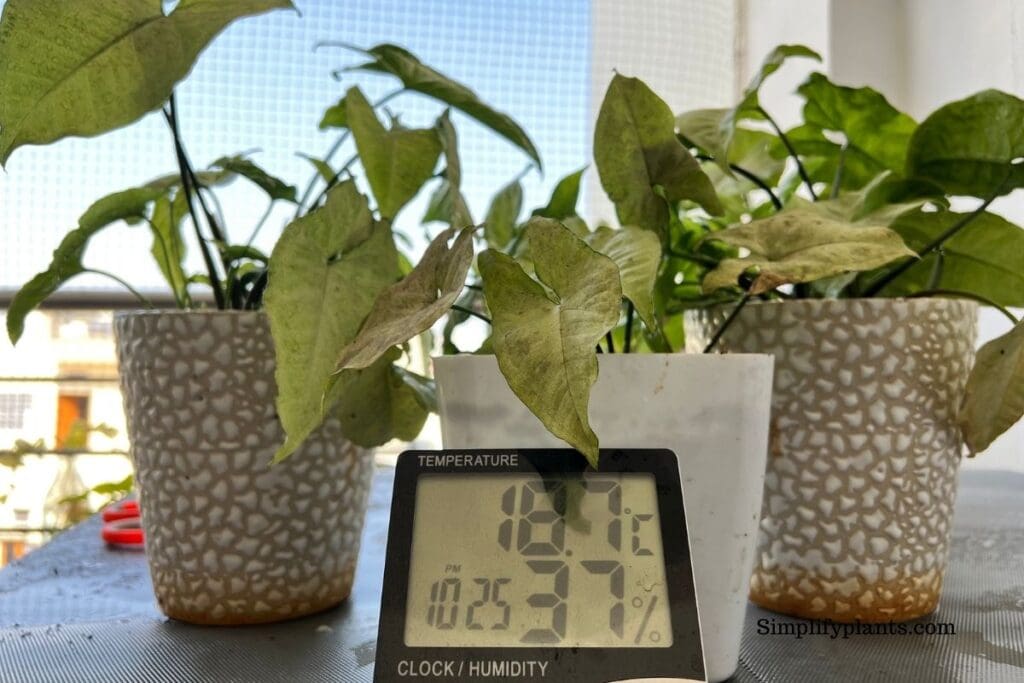
Arrowheads come from tropical and subtropical regions exposed to high humidity levels up to 70-80%.
If grown as an indoor plant, they will require minimum humidity of around 40-50% to survive.
If the humidity level drops below 40-50%, you may not see any new growth as they can’t tolerate such low humidity levels.
Low humidity can cause them to develop many other leaf problems, and therefore, in such cases, you should take steps to increase the moisture level for your plant.
Also read: Do Arrowhead Plants Like Humidity? (+Misting?)
Temperature fluctuations

Arrowhead being tropical plants prefer warm and humid climates.
They will grow well when temperatures range between 65-80°F.
They cannot withstand freezing temperatures.
Arrowheads will not grow and get stressed if temperatures fall below 50°F.
Indoor temperatures that are too cold can even lead to the death of the plant.
Also read: Do Arrowhead Plants Go Dormant? (Winter Dormancy+Care)
Stress
If all their needs of your Syngonium are met, and still they are not growing, it may be because you haven’t repotted them.
If they haven’t been repotted in a few years, they will slow down their growth.
Stress can happen due to many other reasons such as temperature fluctuations, cold and hot drafts, frequent relocations, air currents, etc.
Before taking any action, try to determine why your arrowhead plant is stressed and find ways to relieve them.
Pest attack

Pests are one of the most serious problems that can kill your plant if not treated on time.
Unfavorable conditions such as high humidity levels, overwatering, warm temperatures attract pests to the plants.
Arrowheads are prone to common pests such as spider mites, mealybugs, scales, and aphids.
These sap-sucking insects take up all the nutrients and moisture the plant needs.
Without this, the plant will become weak and vulnerable to other diseases.
Pest grows very fast, so you should take action as soon as possible as you find them on the plant.
Also read: Bugs On Arrowhead Plant: Common Pests+How To Get Rid Of Them
Season
Your arrowhead will show the most growth during its growing season.
Depending on the location, the growing season is typically from the middle of April to the middle of July.
They will slow down their growth in the cold winter months or show no growth.
Winters are unfavorable for them, and so instead of growing, they save energy and focus more on surviving during this season.
You should get worried as it is a natural process, and they grow again when the dormant season ends.
How can I make my arrowhead plant grow?

Arrowheads are easy to care for plants, and you can grow them well by providing proper care and the required conditions.
They can grow at their usual speed and overcome unfavorable situations with the right care.
Here are some tips and ways you can follow to encourage your plant’s growth.
Sufficient light
Arrowheads are plants that neither like too low light nor too bright light.
All arrowheads varieties prefer bright, indirect, or dappled light except for the greener varieties that can tolerate medium light levels.
The ideal place for your plant would be an east-facing or north-facing windowsill that can provide them with sufficient light throughout the day.
But ensure that the sun ray is not directly falling over the plant as it may cause their leaves to scorch.
Keep the arrowhead 5-7 feet away from the window if it receives much sunlight.
Rotate the pot twice a week so that all of its sides will receive an equal amount of sunlight.
If you think your Syngonium is not getting sufficient light, use artificial or grow lights.
Also read: Arrowhead Plant Light Needs: What Type, How Much & More
Proper watering schedule

Arrowheads grow actively in the summer and spring months, and during this time, they need maximum watering.
During the active period, you should regularly check the soil’s moisture level and figure out whether your plant needs watering or not.
Generally, you should water your plant when the soil moisture is about 50% dry.
You can check the moisture by poking your Index finger about an inch into the soil.
If 50-75% of the soil is dry, water your plant thoroughly until it runs out of the drainage holes.
Also, allow the plant to dry out partially between each watering.
Reduce watering during the winter months to prevent any overwatering issues.
Also read: How To Water Arrowhead Plant? (How Often+Summer & Winter)
Adequate fertilization

Your arrowhead will be happiest when you regularly feed them during its growing season.
The spring and summer months fertilize the plant with a diluted 10:10:10 or 20:20:20 liquid fertilizer as per the label instruction.
You can give liquid fertilizers to the plant every two weeks.
You can use an all-purpose household fertilizer for fertilizing your potted arrowheads.
Timely repotting
If you haven’t repotted your arrowhead plant for long, and it has stopped growing, you fix the issue by immediately repotting it.
Here are the steps for repotting your arrowhead plant:
- First, select a pot bigger than the previous pot to give the plant enough space to grow freely. Also, make sure that the pot contains enough drainage holes.
- Then you need to fill the pot with a potting mix that is well-draining and organic for your plant’s better growth.
- Next, you need to hold the base of the plant and pull it out of its current pot but be careful not to damage its roots.
- After removing the plant, untangle the roots if they are tightly bound and have grown in a circular motion.
- Now, place the plant in the new pot and add soil from all sides.
- When you are done repotting your arrowhead plant, you should give it a good soak to reduce the stress and help the plant settle.
Also read: Do Arrowhead Plants Like To Be Root Bound? (+Signs & When To Repot)
Selection of correct soil mix and pot

Choose an acidic potting mix with a pH level of 5.5 and 6.5 for growing your arrowhead plant.
The potting mix should have a lot of nutrients and sound drainage.
The ideal soil for arrowheads should be a mix of 50% potting soil, 30% parts of coco coir, and 20% pumice or perlite.
Choose a few inches wider pot so that the roots get enough space for growth.
You can use a terracotta or clay pot to wick away the excess moisture.
Ensure that the pot has working drainage holes at the bottom for draining the excess water.
Maintain the right temperature
Arrowheads are tropical plants and need a warm and humid environment for growth.
Therefore, you should maintain temperatures around 60°F for growing arrowheads.
You can use a thermostat device to check the temperature around the plant.
Never let your plant get stressed by temperature fluctuation.
Bring the plant indoors if the nighttime temperature falls below 60°F.
Always keep them away from cold drafts, open windows, air conditions, or hot radiations.
In winters, protect the plant from low temperatures and frosty locations.
Ensure a humid environment
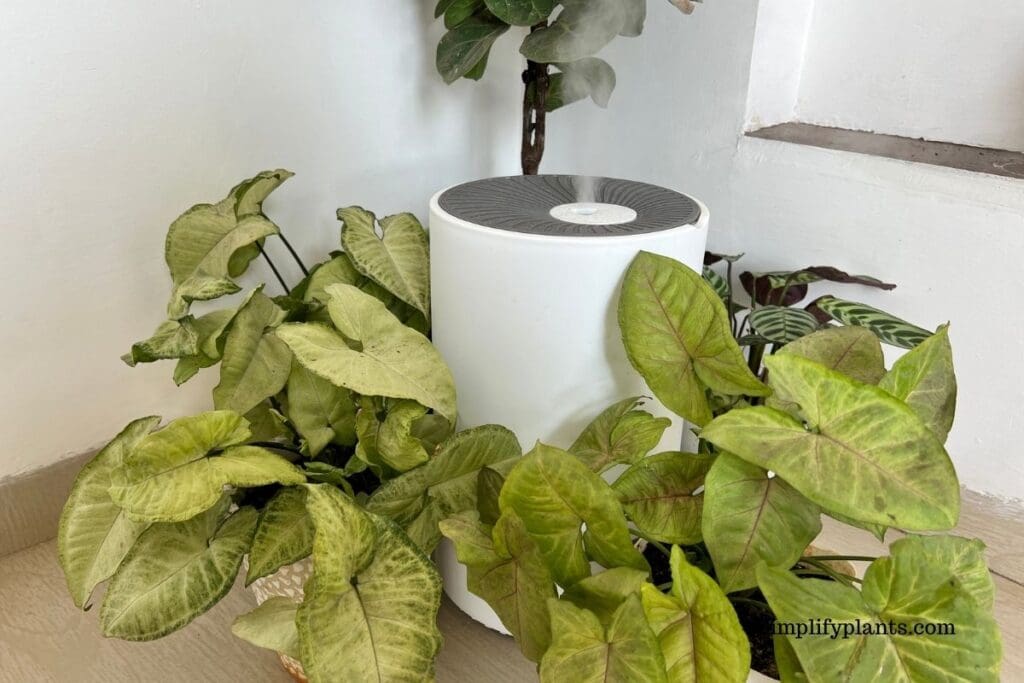
Arrowhead prefers a humid environment for growth, and ideally, you should maintain a minimum of 50% humidity for growing them.
Here are some ways to boost humidity for your plant.
- You can mist your plant’s leaves twice a week with a spray bottle. But this will not be a long-term solution.
- You can place your arrowhead on a tray filled with pebbles and water. The water present in the tray will evaporate and increase the humidity around the plant.
- You can maintain optimum humidity levels for the plant by placing a humidifier in the room where your Syngonium is placed.
- Wipe the leaves of your arrowhead plant with a damp cloth twice a week. This practice will add humidity and keep the leaves clean.
Treatment for pest and diseases
If you saw any signs of pests on your arrowhead plant, consider the following points:
- You can give a shower to your plant with a strong spray of water so that the pests get washed off and, after doing so, leave the plant in a bright spot.
- You can handpick the visible pests.
- You can use alcohol-based insecticidal soaps to remove pests.
- You can dip cotton swabs in rubbing alcohol and wipe the leaves having pests on them.
- You can spray a neem oil solution on your plant every week until the pests disappear.
Winter care

Water your arrowhead plant only when 50-75% of the soil feels dry during the winter season.
Never let the soil dry out completely.
You will notice that your plant will not consume much water during the winter season, so you don’t need to water them frequently.
Avoid fertilizing your arrowhead in the winter and keep it inside the house instead of leaving it outside.
Reference: CABI, Britannica, United States Department of Agriculture, Wikipedia, Children’s Health Queensland Hospital and Health Service, Missouri Botanical Garden.
Recommended Garden Supplies
| Product Image | Our Recommended Gardening Supplies | Check Offers! |
|---|---|---|
Top Top
Top
Top
Top
Top
Top
Top
Top | rePotme Houseplant and Tropical Classic Potting Soil Mix | Check Offer On Amazon |
 Top
Top
Top
Top
Top
Top
Top
Top | Espoma Organic Indoor Plant Food | Check Offer On Amazon |
 Top
Top
Top
Top
Top
Top
Top
Top | GooingTop LED Grow Light 6000K Full Spectrum Clip Plant Growing Lamp | Check Offer On Amazon |
 Top
Top
Top
Top
Top
Top
Top
Top | Soil Moisture Meter | Check Offer On Amazon |
 Top
Top
Top
Top
Top
Top
Top
Top | Govee Hygrometer Thermometer, Bluetooth Enabled! | Check Offer On Amazon |
 Top
Top | LEVOIT Humidifiers for Large Room(Best For Plants) | Check Offer On Amazon |
 Top
Top
Top
Top
Top
Top
Top
Top | Upgraded DIY Automatic Drip Irrigation Kit, 15 Potted Houseplants Support | Check Offer On Amazon |
 Top
Top
Top
Top
Top
Top
Top
Top | Stainless Steel Heavy Duty Gardening Tool Set | Check Offer On Amazon |
 Top
Top
Top
Top
Top
Top
Top
Top | Bonide Insecticidal Soap | Check Offer On Amazon |
 Top
Top
Top
Top
Top
Top
Top
Top | Bonide 32 oz Spray Neem Oil for Organic Gardening | Check Offer On Amazon |
 Top
Top
Top
Top
Top
Top
Top
Top | Garden Safe Fungicide | Check Offer On Amazon |

